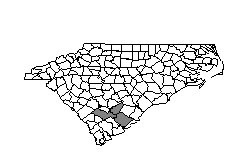![]()
<< Back :: Virginia :: North Carolina :: South Carolina :: Georgia :: FWGNA Home ::
![]()
<< Back :: Virginia :: North Carolina :: South Carolina :: Georgia :: FWGNA Home ::
> Viviparus georgianus
(Lea 1834)
> Habitat & Distribution
Clench (1962) gave the natural range of V. georgianus as “north central
Florida, Georgia, Alabama and north, mainly in the Mississippi River
system, to Illinois and northwest Indiana,” suggesting that the
occurrence of the species throughout the northeast and into Canada
represents a recent (and often human-expedited) invasion.
The six records in our Georgia database are quite patchy in their distribution, giving the appearance of artificial, or at least incidental, dispersal. The single South Carolina population of which we are aware is almost certainly the result of artificial introduction. It inhabits the (quite disturbed) Lakes Marion and Moultrie, formed by impoundment of the Santee River in the late 1940s. The date of introduction may be as late as the mid-1990s. In the summer of 2006 our attention was called to a population of V. georgianus inhabiting the John H. Kerr Reservoir on the VA/NC border. Further spread of that population into North Carolina would seem inevitable.
> Ecology & Life history
Filter feeding has been documented in Viviparus
by Cook (1949). But standard grazing also seems to be an
option. The Lake Marion snails are commonly observed crawling on
macrophytes and other solid substrates.
Northern V. georgianus
populations show a broad range of life cycle pattern, maturing in a
single year and reproducing iteroparously (Browne 1978), maturing in
two years and reproducing iteroparously (Buckley 1986), and maturing in
three years followed by semelparous reproduction (Jokinen et al.
1982). Applying the classification system of Dillon (2000: 156 –
162) these would be life cycle patterns G, Hi,
and T, respectively. Browne
reported a 9-month gestation period (June – March) in his New York
populations. The (apparently natural) mortality that may follow
reproduction can yield spectacular accumulations of dead shell.
The energetic data collected by Browne (1978) suggested to Dillon
(2000: 126 – 131) that V. georgianus
is Undifferentiated with
regard to its life history adaptation.
> Essay #1
I posted an essay on invasive viviparids in South Carolina to the FWGNA
web site on 29October2003. There are links to several additional
photos.
> Essay #2
In 2007 Viviparus georgianus
was implicated as the primary intermediate host for digenean
trematodes causing massive waterfowl mortalities in
Minnesota.
> Taxonomy & Systematics
Viviparus georgianus was originally described based on specimens taken from the Altamaha River (Clench 1962). The taxonomy of American Viviparus
has been stable since the brief monograph of Clench & Fuller
(1965). The allozyme study of Katoh & Foltz (1994) has
suggested, however, that populations referred to V. georgianus in Florida may
represent as many as three cryptic species: goodrichi and limi in the panhandle and georgianus (s.s.) further
east.
>Maps of Viviparus distribution
Click the small map to enlarge
it, or download the state-specific PDF

South Carolina (PDF)
Georgia (PDF)
> References
Aldridge, D.W., Russell-Hunter, W. D.,
& Buckley, D.E. (1986) Age-related differential
catabolism in the snail, Viviparus
georgianus, and its significance in the bioenergetics of sexual
dimorphism. Can. J. Zool. 64: 340-346. Browne, R. A. (1978)
Growth, mortality, fecundity, biomass and productivity of four lake
populations of the prosobranch snail, Viviparus
georgianus. Ecology 59: 742-750. Buckley, D.E. (1986)
Bioenergetics of age-related versus size-related reproductive tactics
in female Viviparus georgianus
. Biol. J. Linn. Soc. 27: 293-309.
Clench, W. (1962) A catalogue of the Viviparidae of North
America with notes on the distribution of Viviparus georgianus, Lea. Occas.
Pprs. on Mollusks, Mus. Comp. Zool. Harvard, 2, 261-87. Clench, W. & Fuller, S. (1965)
The genus Viviparus in North
America. Occas. Pprs. on Mollusks, Mus. Comp. Zool. Harvard, 2, 385-412. Cook, P. (1949) A
ciliary feeding mechanism in Viviparus
viviparus (L). Proc. Malacol. Soc. Lond. 27: 265-271. Jokinen, E.H., Guerette, J,
& Kortmann, RW (1982) The natural history of an
ovoviviparous snail, Viviparus
georgianus (Lea), in a soft-water eutrophic lake.
Freshwat. Invertebr. Biol. 1: 2-17.
Katoh, M. & Foltz, D. W. (1994) Genetic subdivision and
morphological variation in a freshwater snail species complex formerly
referred to as Viviparus georgianus
(Lea). Biol. J. Linn. Soc. 53: 73-90. Vail, V.A. (1977) Comparative
reproductive anatomy of 3 viviparid gastropods. Malacologia, 16:
519-520. Vail, V.A. (1978)
Seasonal reproductive patterns in 3 viviparid gastropods.
Malacologia, 17: 73-97.
Robert T. Dillon, Jr.
Department of Biology, College of
Charleston
Charleston, SC 29424
P: 843.953.8087
F: 843.953.5453